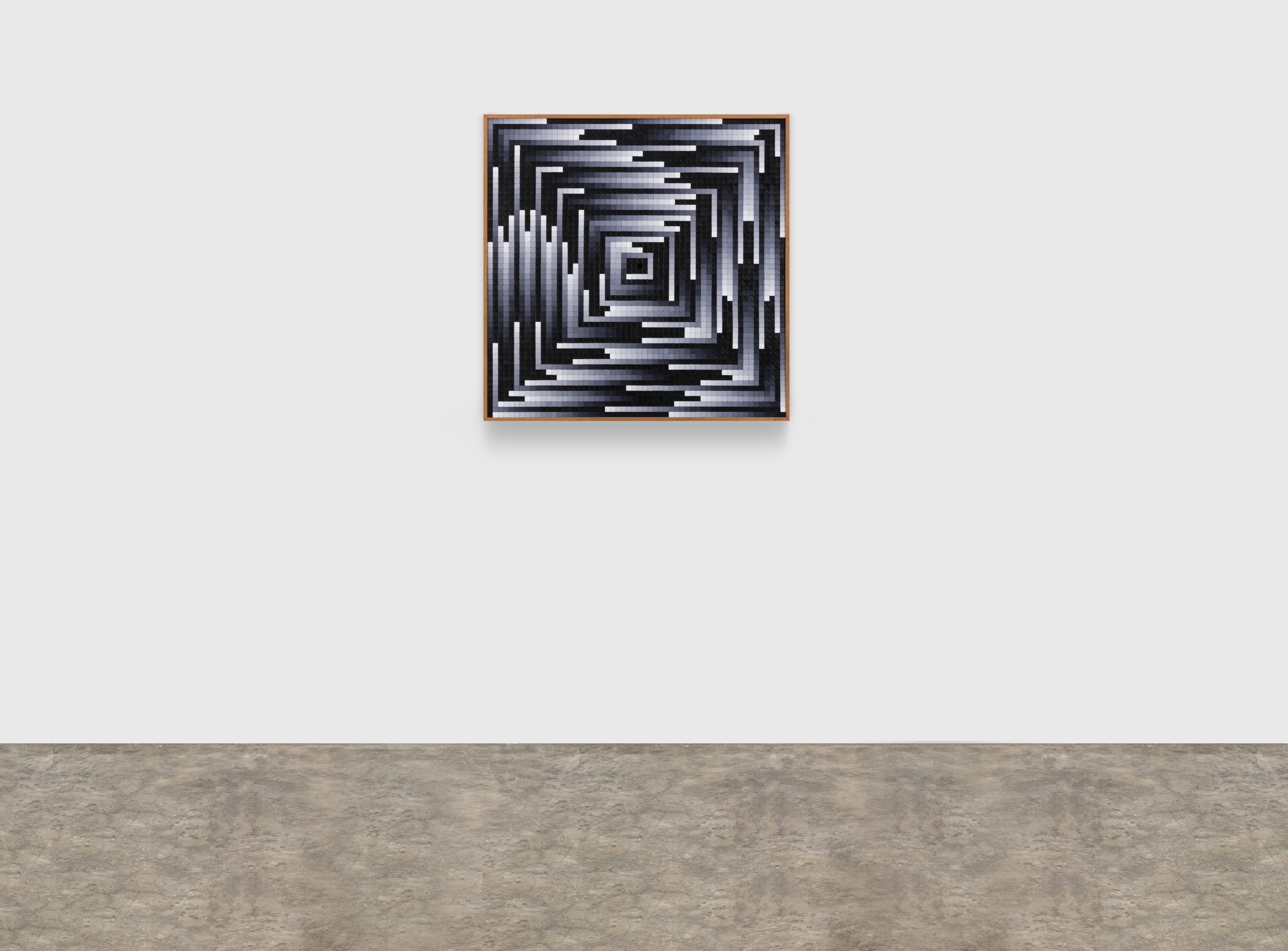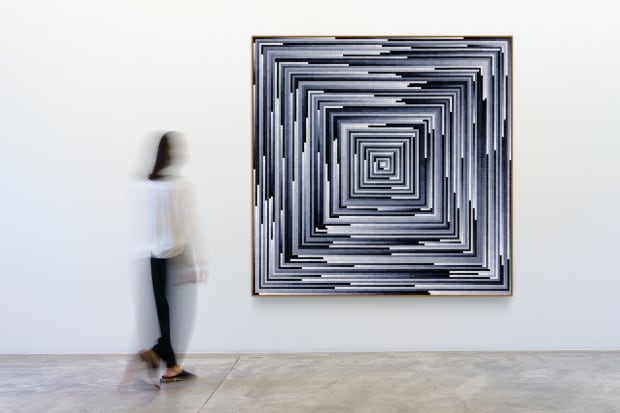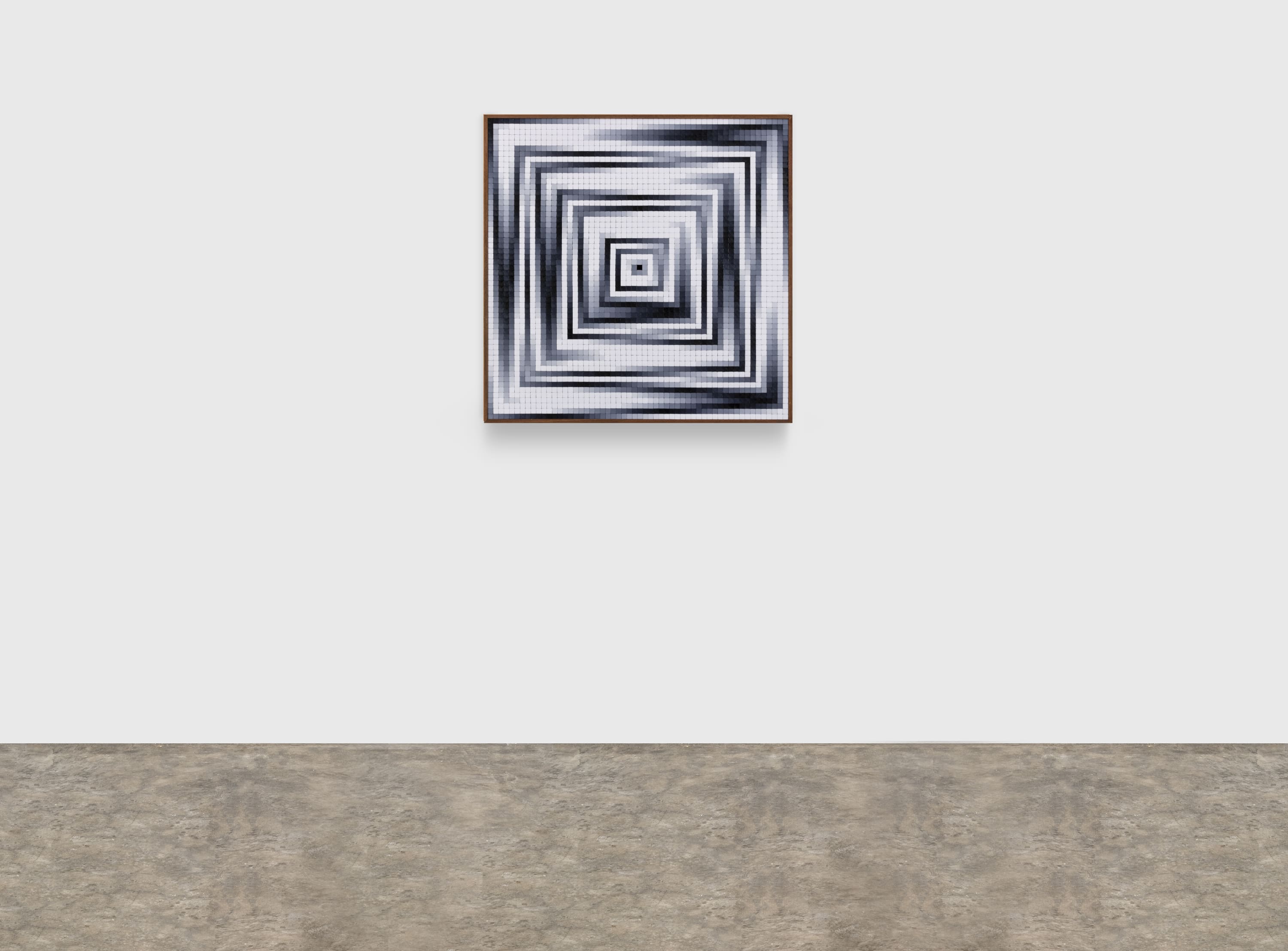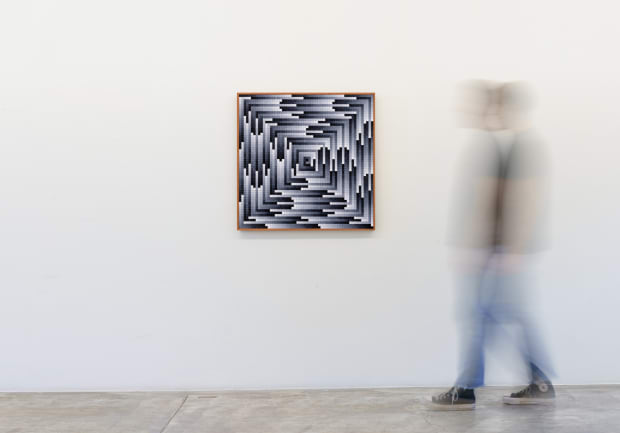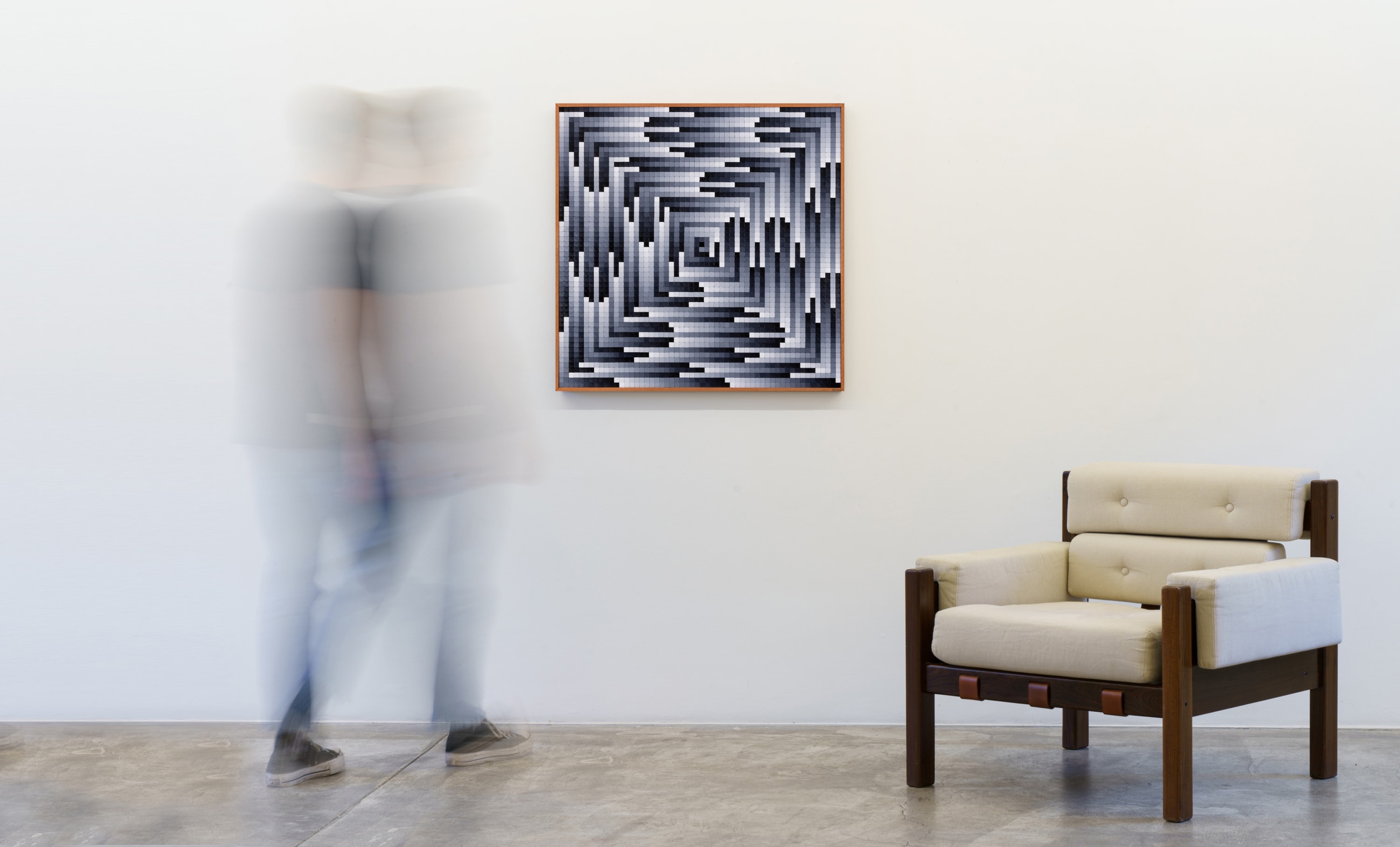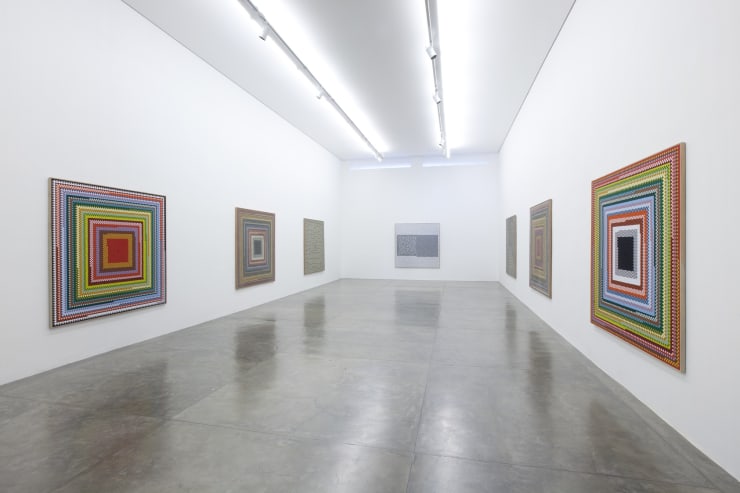-
josé patrício
potência criadora infinita
curadoria de paula braga
22 de maio – 24 de julho, 2021
nara roesler são paulo
-
-

José Patrício
Circuito tonal em progressão crescente I, 2019
peças de quebra-cabeças de plástico sobre madeira
190 x 190 x 4 cm
-
 Vista de exposição | Foto ©️ Flávio Freire
Vista de exposição | Foto ©️ Flávio Freire -
-
José Patrício: Potência criadora infinita
Paula Braga
Everything in the world, in its immeasurable variety, consists of a finite number of atoms that recombine to form every flower, every hair, every stone, every piece of plastic. It is an immense quantity of particles of a magnitude far greater than the human intellect can conceive. Huge, unimaginable, but finite. What is infinite is the creative power of combinations between these atoms. We call this the infinite power of Nature.
José Patrício’s work is an exercise in invoking this creative force. From a fixed number of elements, such as dominoes or puzzle pieces, Patrício elaborates variations that play with the sequential possibilities of the chosen elements.
The artist’s most recent works use identical plastic pieces whose colors vary in a gradient of twenty-two shades of gray, ranging from white to black. The tonal economy highlights the combinatorial structure of each work, allowing for the identification of the rule that generates the uniqueness of each work.
-

José Patrício
Circuito tonal V, 2019
peças de quebra-cabeças de plástico sobre madeira
81 x 81 x 4 cm |
-
-

José Patrício
Circuito tonal em progressão crescente II, 2019
peças de quebra-cabeças de plástico sobre madeira
190 x 190 x 4 cm
-
The artist’s task is to devise a mathematical formula for each composition of pieces within the gray gradient. Thus, he starts a piece in white and goes on to black, and then starts the sequence again, mounted in spiral rows, from the edge to the center of a board. In another work, the same ordering begins in the center and opens itself towards the edges. In yet another piece, the gradient follows the diagonal lines from the vertices of the board to its center, and so on... finitely. Unlike Nature, the time that the artist has to exercise this creative power is finite.
José Patrício’s insistence on the repetition of the creative process is a struggle against the painful limit of time available for each human being to create. In this sense, it is possible to understand his work as an exercise in questions of time. Every object that leaves the artist’s studio not only carries the time of the craftsmanship involved in its creation, but above all, also holds a key to understanding temporality. What one deciphers with the long contemplation of these spirals is not the forming rule of the sequence, but rather the fundamental enigma: how can we – piece by piece, step by step – constitute a charming movement in life within the time we have?
-

José Patrício
Circuito tonal IV, 2019
peças de quebra-cabeças de plástico sobre madeira
81 x 81 x 4 cm
-

José Patrício
Circuito tonal VII, 2019
peças de quebra-cabeças de plástico sobre madeira
81 x 81 x 4 cm
-

José Patrício
Circuito tonal VI, 2019
peças de quebra-cabeças de plástico sobre madeira
81 x 81 x 4 cm
-
Time is also the element that carries José Patrício’s work from the guidelines defined by the Concrete Art Manifesto, from 1930, to the sensitivity of the 1959 Neoconcrete Art Manifesto. The first, launched in Paris by the Dutch artist Theo van Doesburg, advocated that the art of a new era should follow six characteristics, easily identifiable in José Patrício’s work:
1. Art is universal: produced in Pernambuco in the last two years, the compositions presented in this exhibition are as universal as a mathematical formula. They could exist anywhere and at any time;
2. The work of art must be entirely conceived and formed by the spirit before its execution: each arrangement by José Patrício derives from a mentally defined rule which is strictly followed;
3. The work must be built with purely plastic elements, such as planes and colors, so the final work has no other meaning than “itself”: averse to representativeness, José Patrício creates structures, all of which establish a new element in the world, related only to the mathematical idea that formed it;
4. The construction of the work must be simple and visually controllable: it is possible to identify the numerical rule that led to the making of the work, such as seven black pieces, followed by six gray pieces, followed by five lighter gray pieces, and so on until the white ones;
5. The technique must be mechanical: José Patrício’s works are made by the mechanical repetition of a manual gesture, of fitting, carried on the same way whatever the hand that manipulates the piece;
6. Striving for absolute clarity: there is nothing that is not in sight in José Patrício’s works;
-
-
 Vista de exposição | Foto ©️ Flávio Freire
Vista de exposição | Foto ©️ Flávio Freire -

José Patrício
Circuito tonal VIII, 2019
peças de quebra-cabeças de plástico sobre madeira
81 x 81 x 4 cm
-
-
Taking a step beyond concretist rationality, every work by Patrício incites questions about time –and this is where there is a dialogue with Neoconcretism. The intellectual excitement that explicit mathematics causes in the viewer, the pursuit for the forming rule of the composition does not matter as much as the sensory effect caused by the optical kinetics of the pieces, and the psychological effect that unfolds in various temporal issues. Or, as stated by the Neoconcrete Manifesto,
it will be of specific cultural interest to determine the approximations between artistic objects and scientific instruments, between the artist’s intuition and the objective thought of the physicist and the engineer. But, from the aesthetic point of view, the work becomes of interest precisely for its possessions in what transcends these external approaches: for the universe of existential meanings that it founds and reveals at the same time.
-

José Patrício
Sequências em preto e branco, 2019
peças de quebra-cabeças de plástico sobre madeira
103 x 103 x 4 cm
-
-
A work such as Expansão e retração tonal [Tonal Expansion and Retraction] is mathematically decipherable, as it consists of two squares and opposite movements, one centripetal and the other centrifugal, in the distribution of the pieces of the gray gradient. It is also mathematically understandable that the edgy rows extend themselves, without changing the color of the pieces, for a few more turns at the periphery of the board, resulting in black and white stripes. Here’s the algorithm. But knowing this does not exhaust the work.
Sensorially, this composition seems to draw our eye to the center of each square, which is bright on one side and dark on the other. The black and white stripes on the edges confuse perception: are there two or three bands of each color? The analysis of the work becomes even more interesting when it addresses the psychological reactions of the viewer who faces the two vortexes of the composition. What are they? Naked, raw autonomy produces a kind of semiological distress. Even if we recognize the connection with everyday life that the puzzle pieces suggest –something more easily identifiable in the dice and dominoes of other series by José Patrício–, they defy, in their structural totality, our efforts to connect them to something previously known. It is as if they were the “quasi-corpus” of the Neoconcrete Manifesto: “a being whose reality is not limited to the external relations of its elements; a being that, decomposable in parts by analysis, is only fully given to the direct, phenomenological approach.”
-

José Patrício
Expansão e retração tonal - infinity, 2019
peças de quebra-cabeças de plástico sobre madeira
114,5 x 215 cm
[vendida]
-
Sensorially, this composition seems to draw our eye to the center of each square, which is bright on one side and dark on the other. The black and white stripes on the edges confuse perception: are there two or three bands of each color? The analysis of the work becomes even more interesting when it addresses the psychological reactions of the viewer who faces the two vortexes of the composition. What are they? Naked, raw autonomy produces a kind of semiological distress. Even if we recognize the connection with everyday life that the puzzle pieces suggest –something more easily identifiable in the dice and dominoes of other series by José Patrício–, they defy, in their structural totality, our efforts to connect them to something previously known. It is as if they were the “quasi-corpus” of the Neoconcrete Manifesto: “a being whose reality is not limited to the external relations of its elements; a being that, decomposable in parts by analysis, is only fully given to the direct, phenomenological approach.”
-

José Patrício
Tramas tonais V, 2020
peças de quebra-cabeças de plástico sobre madeira
190 x 190 x 4 cm
-

José Patrício
Tramas tonais VI, 2020
peças de quebra-cabeças de plástico sobre madeira
190 x 190 x 4 cm
-
 Vista de exposição | Foto ©️ Flávio Freire
Vista de exposição | Foto ©️ Flávio Freire -
-
The works of the exhibition José Patrício: Infinite Creative Power are beings that demand coexistence to be known. All we can do is to start this relationship, from being to being, with the work, which is extremely independent, self-sufficient, as if it could live well without our eyes. It is certainly not a living organism, but it is an aesthetic organism, which is beyond the mere object. And what gives these works the character of independence and silent existence is precisely the time. They were laboriously built in time, given time from the hand that fit each piece of the puzzle. And now they pulse in a perennial temporality, which has the eternity of mathematics. And we, the viewers, are much more finite than that.
-

José Patrício
Circuito tonal em quatro fases, 2019
peças de quebra-cabeças de plástico sobre madeira
81 x 81 x 4 cm
-

O trabalho de José Patrício se realiza na fronteira entre instalação e pintura, misturando esses gêneros. Sua prática parte do arranjo de objetos cotidianos, tais como dominós, dados e botões, a fim de criar padrões e imagens que podem ter caráter geométrico ou orgânico, ainda que não deixem de resguardar uma familiaridade enigmática com o cotidiano, tendo em vista a possibilidade de se reconhecer aqueles elementos nas composições. Patrício despontou no mundo da arte em 1999, quando criou uma instalação para o convento de São Francisco, em João Pessoa. Na ocasião, o artista utilizou dominós como elemento-chave para muitos dos seus trabalhos. Quando vistos de longe, os padrões observados ganham uma qualidade pictórica (dada sua configuração geral) que contrasta com a natureza gráfica individual de cada peça.
Sob a influência de importantes tendências e movimentos artísticos brasileiros, como a abstração geométrica e o concretismo, Patrício enfatiza o limite sutil entre a ordem e o caos e sugere que mesmo a mais rígida das fórmulas matemáticas possui uma potencial dimensão expressiva. Para o crítico e curador Paulo Sérgio Duarte, o procedimento de acumulação de Patrício nos leva a um “patamar diferente das questões colocadas pelo progresso da ciência e da técnica para a obra de arte. [...] Incorporado, como ponto de partida, o terreno da combinatória matemática, nos encontramos com a combinação das séries, reitero, infinitas nas suas possibilidades. O problema não é mais a reprodução do mesmo; trata-se, agora, de, a partir do mesmo, produzir infinitos outros.”
exposições individuais selecionadas
• Precisão e acaso, Museu Mineiro, Belo Horizonte; Museu Nacional de Brasília (MUN), Brasília, Brasil (2018)
• Explosão Fixa, Instituto Ling, Porto Alegre, Brasil (2017)
• José Patrício: O número, Centro Cultural Banco do Nordeste Cariri (CCBNB-Cariri), Cariri, Brasil (2011); Caixa Cultural, Rio de Janeiro, Brasil (2010); Centro Cultural Banco do Nordeste (CCBNB-Fortaleza), Fortaleza, Brasil (2010)
• Expansão múltipla, Pinacoteca do Estado de São Paulo (2008), São Paulo, Brasil
exposições coletivas selecionadas
• Ateliê de Gravura: da tradição à experimentação, Fundação Iberê Camargo (FIC), Porto Alegre, Brasil (2019)
• Géométries américaines, du Mexique à la Terre de Feu, Fondation Cartier pour l’art contemporain, Paris, França (2018)
• Spots, Dots, Pips, Tiles: An Exhibition about Dominoes, Pérez Art Museum Miami (PAMM), Miami, EUA (2017)
• Art in Brazil (1950–2011), Palais des Beaux Arts, Bruxelas, Bélgica (2011)
• 8a Havana Biennial, Cuba (2003)
• 22a Bienal de São Paulo, Brasil (1994)
• 3a Bienal do Mercosul, Porto Alegre, Brasil (1994)
coleções selecionadas
• Fondation Cartier pour l’art contemporain, Paris, França
• Museu de Arte Moderna Aloisio Magalhães (MAMAM), Recife, Brasil
• Museu de Arte Moderna da Bahia (MAM-BA), Salvador, Brasil
• Museu de Arte Moderna do Rio de Janeiro (MAM Rio), Rio de Janeiro, Brasil -
Watch the videos of José Patrício's previous exhibitions at Nara Roesler



